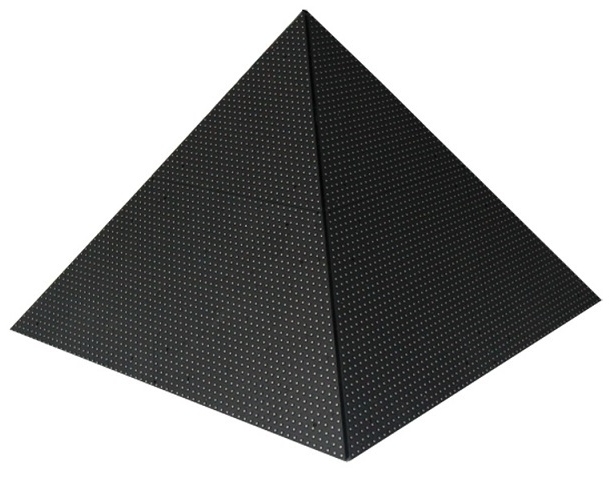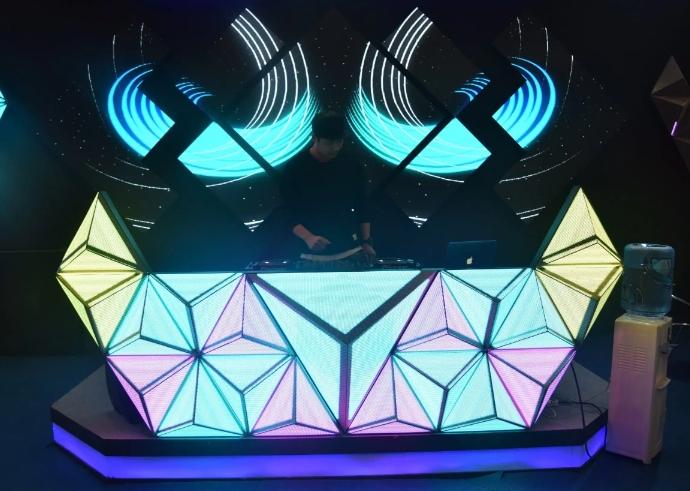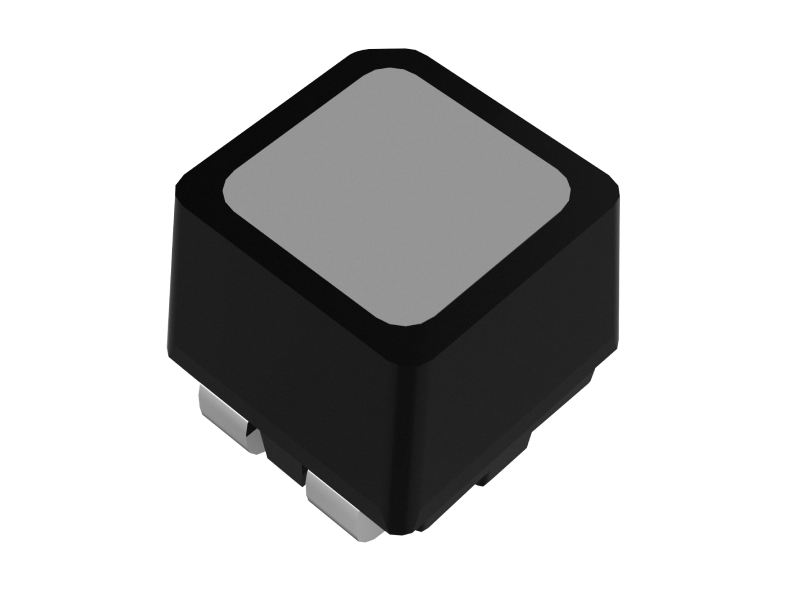Irregular shaped LED displays are more commonly seen nowadays since their popularity increased for events and shows, especially for creative designs and special visual impact. Among them, triangle LED displays develop more possibilities for irregular designs of concerts, stages and ceremonies.
A triangle LED display, just as its name, is a triangle shaped irregular LED display. It is designed with LED modules or panels arranged in a triangular configuration, allowing for unique and eye-catching display installations. Triangle LED displays offer versatility in terms of design possibilities and can be used for various applications, including advertising, art installations, stage backdrops, and architectural displays.

Triangle LED panels are usually used to build pyramid displays
Here are some key characteristics and considerations regarding triangle LED displays:
Shape and Configuration: Triangle LED displays are specifically designed to form a triangular shape. They consist of individual LED modules or panels that are arranged and connected to create the desired triangle configuration. The modules are typically lightweight and slim to facilitate easy installation and maintenance.
Customization and Flexibility: Triangle LED displays can be customized in terms of size, resolution, and pixel pitch to meet specific requirements. The modular nature of LED panels allows for flexibility in creating larger or smaller triangle displays by combining multiple modules together.
Seamless Integration: Triangle LED displays are designed to ensure seamless integration between individual LED modules, resulting in a smooth and continuous display surface. This allows for uninterrupted visuals and content across the entire triangular shape.
Content Creation and Control: Triangle LED displays can be controlled and managed using dedicated software and control systems. This enables content creation, scheduling, and real-time updates for dynamic and engaging visual displays.
Creative Applications: Triangle LED displays offer unique design possibilities and can be used to create visually striking installations. Their triangular shape allows for geometric patterns, 3D effects, and the combination of multiple triangle displays to form larger structures or artistic arrangements.
Viewing Perspective: When designing triangle LED displays, it’s important to consider the viewing perspective and angle. Since triangle displays have three sides, the content should be optimized to ensure visibility from various viewing angles.
Triangle LED displays can add a visually captivating element to various environments, including retail spaces, exhibitions, museums, and entertainment venues. Their distinct shape and flexibility make them an attractive choice for those seeking innovative and attention-grabbing display solutions. When considering a triangle LED display, factors such as resolution, pixel pitch, image quality, control systems, and installation requirements should be taken into account to ensure the desired outcome.

Triangle LED displays are used for irregular DJ booth creation.
Triangle LED displays have unique design possibilities and can be used in a variety of applications to create visually captivating and engaging displays. Here are some common applications of triangle LED displays:
Advertising and Retail: Triangle LED displays can be used for advertising and promotional purposes in retail environments. They can be placed in store windows, on product displays, or as part of interactive signage to attract attention and showcase products or brand messaging.
Art Installations: Triangle LED displays offer a creative canvas for artists and designers to create immersive and dynamic art installations. The triangular shape allows for the exploration of geometric patterns, 3D effects, and interactive visual experiences.
Stage and Concert Backdrops: Triangle LED displays can be used as stage backdrops or set pieces in concerts, theatrical productions, or live events. They can enhance the visual impact of performances, create immersive environments, and provide dynamic content synchronization with music and lighting effects.
Architectural Displays: Triangle LED displays can be integrated into architectural structures to create unique and visually striking facades. They can be used to display decorative patterns, information, or dynamic visuals that complement the building’s design and aesthetic.
Exhibition and Museums: Triangle LED displays can be utilized in exhibitions and museums to present information, showcase artwork, or provide interactive experiences. Their unique shape and flexibility allow for creative and engaging display arrangements.
Event Decor and Entertainment: Triangle LED displays can be used as decorative elements in events such as weddings, parties, or corporate functions. They can create visually appealing focal points, serve as stage props, or provide dynamic lighting effects.
Digital Signage and Wayfinding: Triangle LED displays can be integrated into digital signage systems to provide directional information, display advertisements, or deliver real-time updates in public spaces such as airports, malls, or transportation hubs.
Educational and Training Environments: Triangle LED displays can be used in educational settings to enhance visual learning experiences. They can display diagrams, animations, or interactive content to engage students and facilitate understanding.

Kinglight offers a wide variety of LEDs for triangle LED display creation.
These are just a few examples of the applications of triangle LED displays. The versatility, unique shape, and creative possibilities of triangle LED displays make them suitable for a wide range of environments and purposes. The specific application will depend on the desired visual effect, content requirements, installation considerations, and the overall objectives of the display project.